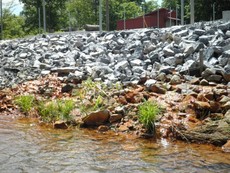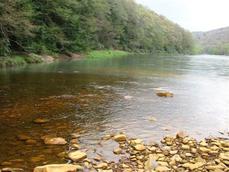Abandoned Mine Drainage

Mining is arguably the backbone of our nation’s economy. Since the early days of pioneer settlement mining has provided a way of life not just for miners and their families but also for a nation dependent on mineral extraction. Despite its valuable economic significance mining is also responsible for devastating impacts to America’s fisheries and is one of this country’s most detrimental environmental trespasses.
According to the West Virginia Geological and Economic Survey the presence of coal in the Allegheny Mountains was first referenced as early as the mid-1700’s. Mining throughout the East soon followed as extensive logging provoked reduced lumber availability. Soon, the mere presence of coal sparked a furry of crude extraction operations and coal towns consisting of company-owned stores and dilapidated houses began to dot the landscape. Coal in the Appalachian region alone was so prevalent that by 1900 approximately 30 million tons were being mined from four mountain states.
According to the West Virginia Geological and Economic Survey the presence of coal in the Allegheny Mountains was first referenced as early as the mid-1700’s. Mining throughout the East soon followed as extensive logging provoked reduced lumber availability. Soon, the mere presence of coal sparked a furry of crude extraction operations and coal towns consisting of company-owned stores and dilapidated houses began to dot the landscape. Coal in the Appalachian region alone was so prevalent that by 1900 approximately 30 million tons were being mined from four mountain states.

Early mining operations depended on the perseverance of hard-working men and their agility with a sledgehammer and steel wedge. Progress was painfully slow and efficiency was often lacking. However the efficiency of early mining operations to create large amounts of toxic pollution is unparalleled.
As coal was extracted other naturally occurring elements normally found below the surface and isolated from air and water were left exposed. The weathering of these elements created highly acidic water perfectly suited to leach metals out of the surrounding landscape. The resulting slurry of metal-laden water created catastrophic amounts of pollution. Today, the legacy left behind by historic mining in the East is in millions of acres of treeless landscape and tens of thousands of miles of streams too unhealthy to support fish. According to the Environmental Protection Agency, drainage from coal mines poses the single largest threat to the Appalachian environment.
Historic Summary of Coal Production in Pennsylvania Download pdf
As coal was extracted other naturally occurring elements normally found below the surface and isolated from air and water were left exposed. The weathering of these elements created highly acidic water perfectly suited to leach metals out of the surrounding landscape. The resulting slurry of metal-laden water created catastrophic amounts of pollution. Today, the legacy left behind by historic mining in the East is in millions of acres of treeless landscape and tens of thousands of miles of streams too unhealthy to support fish. According to the Environmental Protection Agency, drainage from coal mines poses the single largest threat to the Appalachian environment.
Historic Summary of Coal Production in Pennsylvania Download pdf
